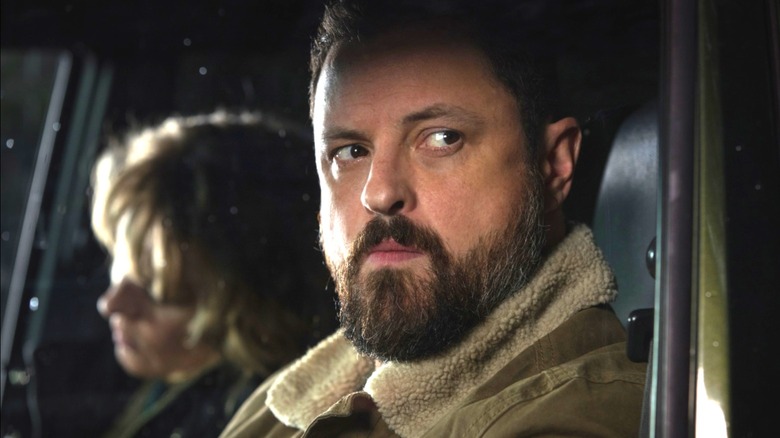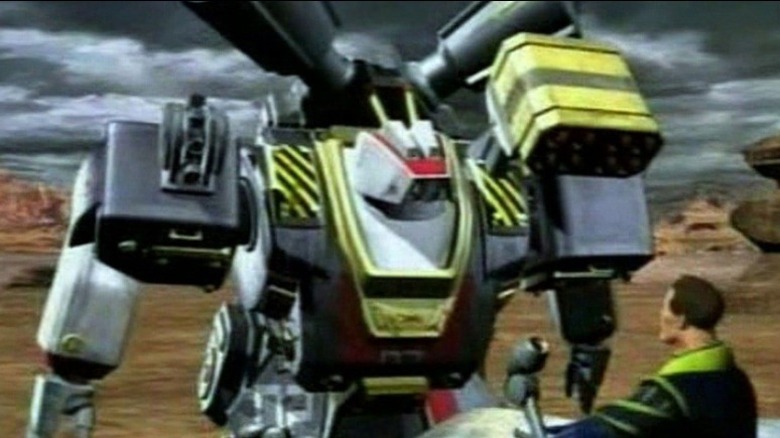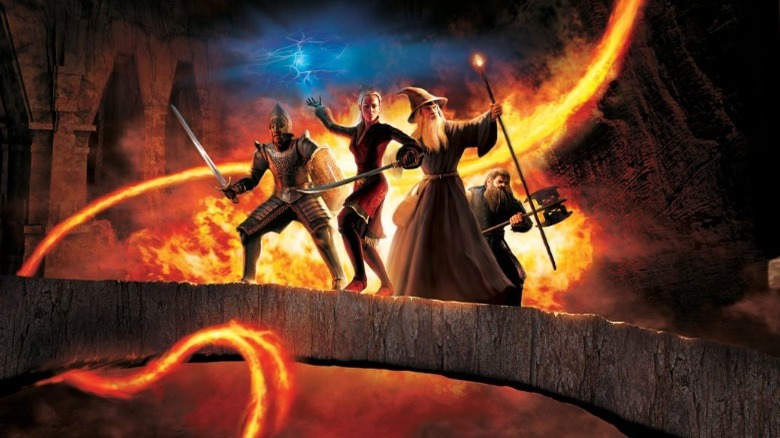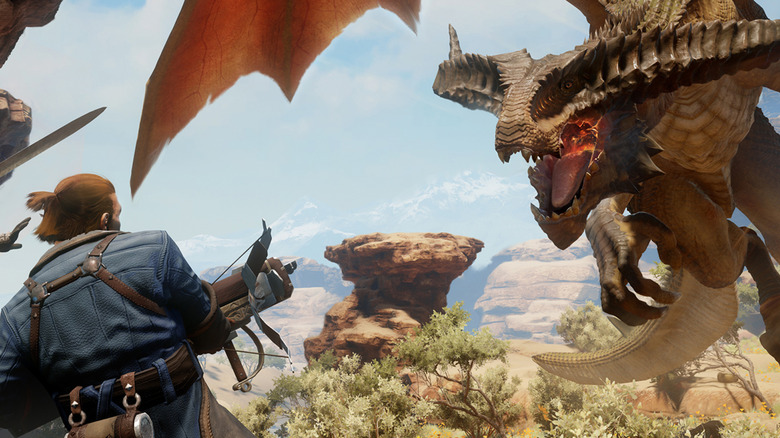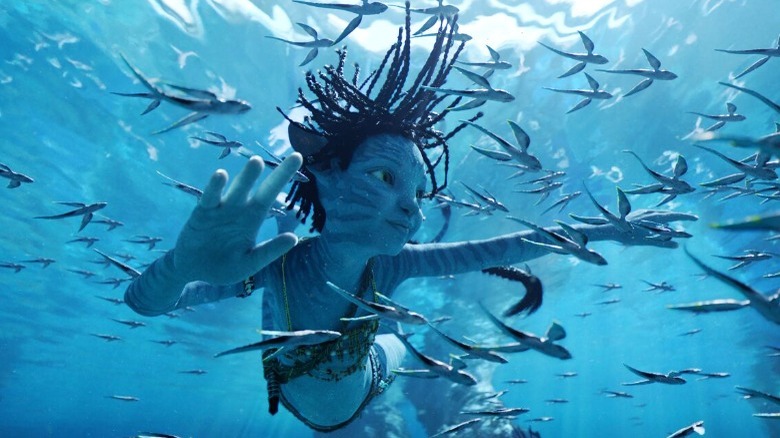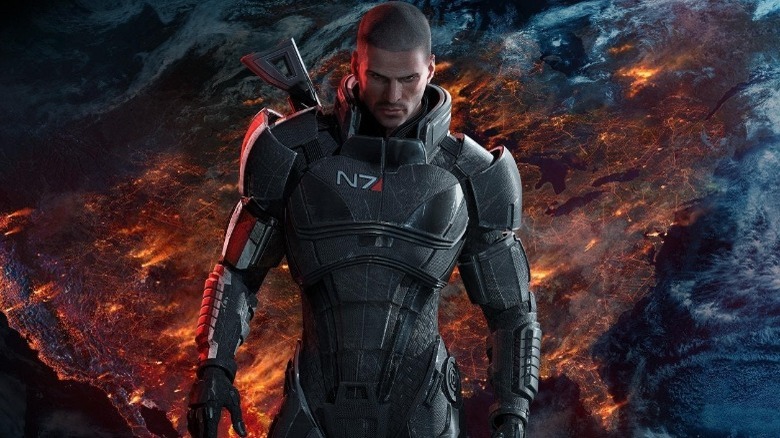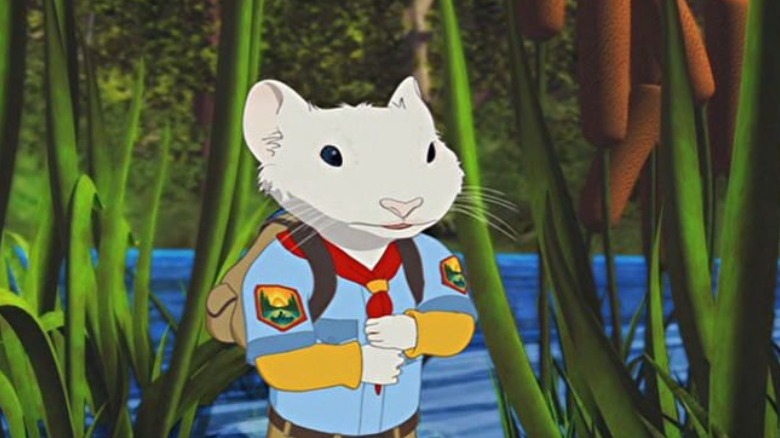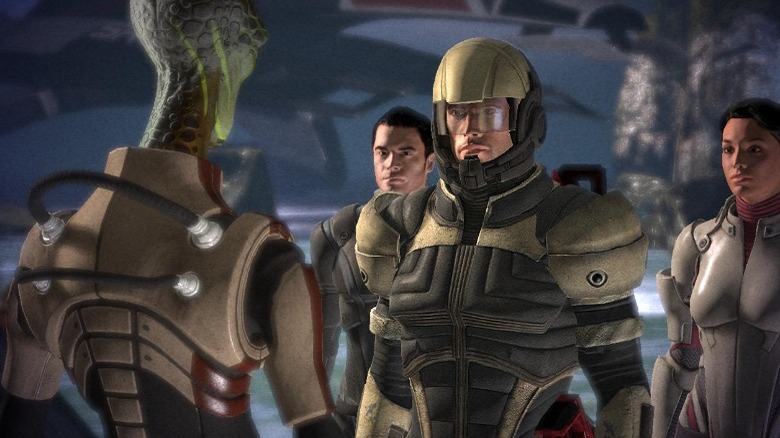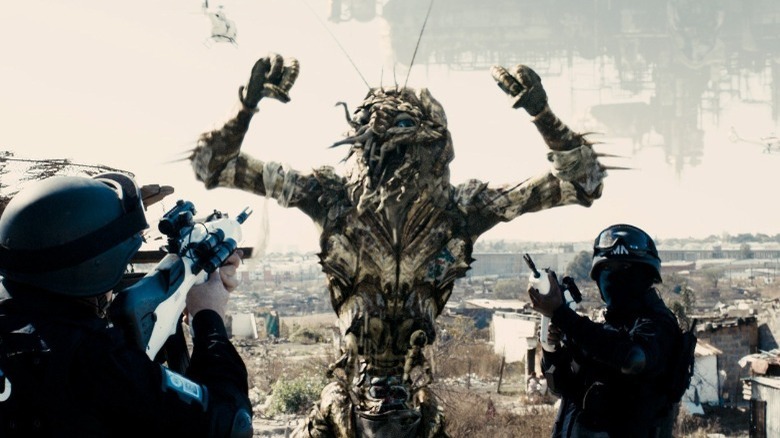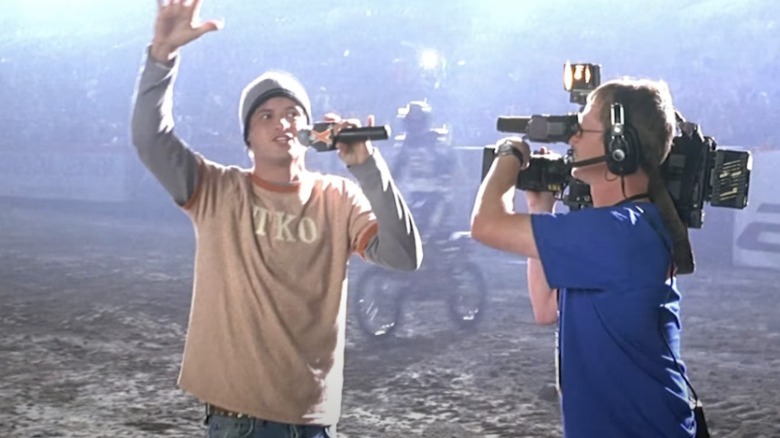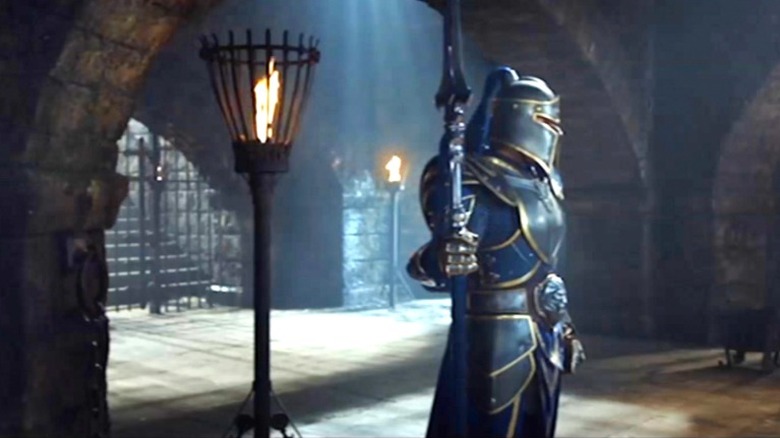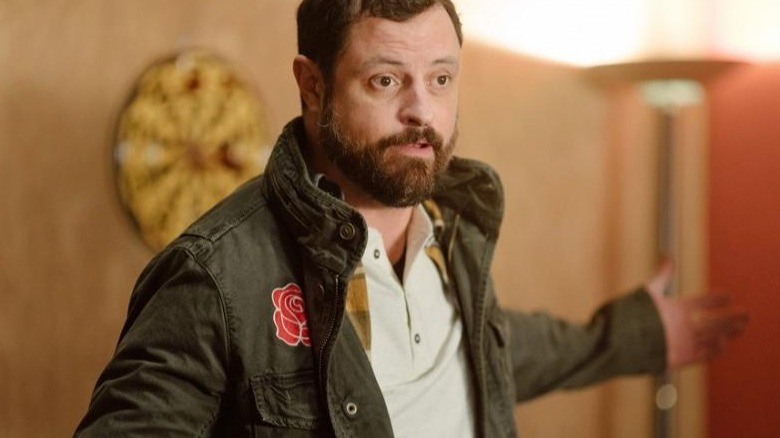Actor Donavon Stinson On The Evolution, Difficulties, And Joys Of Motion Capture [Exclusive Interview]
Any digital artist well-versed in motion capture technology knows that a successful session relies on the performance of the actor. Donavon Stinson has been a witness and participant in the journey of motion capture since its explosion in popularity starting at the turn of the millennium, acting in an extensive list of film and video game productions that includes "District 9," "The Lord of the Rings" video games, and the "Mass Effect" series. The actor's live-action credits include Lifetime series "UnREAL," Shudder's zombie comedy "Dead Shack," and Nickelodeon's revival of "Are You Afraid of the Dark?", among others.
I got the opportunity to talk with Stinson about his career, covering how much work goes into mo-cap performances, how filmmakers and creative directors work with actors on motion capture sets, and how the technology is ever-evolving. The discussion made it clear that acting for motion capture is a lot more than just tennis balls and spandex suits.
Note: This interview has been lightly edited for clarity and brevity.
'EA and the game companies started hearing about me'
Did you initially get into the acting world with the intention of doing motion capture, or were you just going down the traditional [acting] path?
I had moved here to Vancouver in '97 and didn't know if I wanted to get in acting or whatever. [I was] working at a cafe. A friend of mine was working for Mainframe Entertainment at the time — they were known for "Reboot," one of the very first 3D animated cartoon series — and they were auditioning for this show called "Heavy Gear." I never went to school for acting. I had experience with some gymnastics and fight experience.
I didn't have an agent and my friend was like, "Just do it, just see what happens." I was making short films and screwing around with my roommates at the time, who were aspiring actors. I went in and there was a light set up so they could see my silhouette behind me on a white sheet. A guy named Luke Carroll was there, [and] Kimani Ray Smith, who is a director and stunt coordinator. He's done "Snake Eyes" and he's directing quite a bit now. He was acting and still stunting back then. He'd done "Rumble in the Bronx." Anyway, he was my neighbor at one point and he remembered me and I auditioned and then I got the role and it was like 47 episodes of this cartoon. I remember calling my mom and dad being like, "You're not going to believe this, man, but these guys want to pay me $500 a day to jump around like a giant robot."
Then it kind of just snowballed into more work. "Heavy Gear" went from doing those 46 or 47 episodes, some number like that, to, I did this show called "Action Man" where I played Action Man and then "Max Steele." We did one season of a "Spider-Man" series. I played Peter Parker and Spider-Man. It just kept going. But then EA and the game companies started hearing about me and I started going in for EA in I think 2002 [or] 2003.
I think it was getting on at the ground floor in a way. I think that being able to portray many different characters in a day [helped me]. Still to this day, they'll bring me in because I can play six different characters. I did a Marvel thing and I played everyone from the Hulk to Wolverine to Deadpool to Spider-Man to Iron Man. Just the years and years of experience and working so much, it just kept getting me more and more work.
But it's such an interesting field because with the film and TV side, obviously you see your face and you hear your voice and that's [you] on the screen. Whereas motion capture, back in those days and still to some element now, who knows who you are? You just see a body. Back then the Union, UBCP, didn't even know how to categorize motion capture actors back in the early 2000s. They categorized us under puppetry because they were like, "I don't get it. So you don't hear his voice, it's not his voice, it's not his face, it's just his body." So they were like, "We'll just put him into this category." And it wasn't until [Andy] Serkis really put it on the map with Gollum, and Gollum was that thing that was like, "Holy smokes, look at this stuff called motion capture."
'It's now considered to be another acting form'
Motion capture technology is a thing that I imagine is constantly evolving at a pretty fast rate. Have you noticed a shift in the way filmmakers have approached it over the years?
Yeah. It's always, always evolving. I think that in the last ten years, the Vicon systems, a lot of the camera systems that a lot of the studios work, the head rigs, the HMCs that actors are using now. I remember "The Lord of the Rings," we did the "Two Towers" game and "Return of the King" around the time that the movie was coming out, which was really cool because we saw the mouth of Sauron before anyone else. We were like, "Oh my God, look at that." So again, Kimani and a couple other actors, we'd play a lot of different characters. Like I did Gollum and Legolas and Gandalf, and Kimani would do Aragorn and a little bit different humanized characters and trolls, orcs — a lot of orcs.
We went on to a different one called "The Lord of the Rings: The Third Age." That was the very first time that we had ever used facial capture. That was at EA. Back then, they used to put markers. Now they just do dots, they just use a makeup so it's just black dots all over your face. Back then, dude, they used to glue little tiny markers, and I mean everywhere, because back then, it wasn't evolved the way it is today, the cameras and such. So you needed a lot of markers. It would be all around your eyebrows, and they'd stick out. They were on your eyelashes and your lips and your nose. If you just even slightly wiped your face, the markers would go flying off and then you'd have to stop and they'd have to glue them back on.
So going from those kind of markers specifically for facial capture to where it is now — we just worked on a project that I can't talk about. They can do my markers on my face in five minutes and then you do your face rom and then you're done and you're ready to go, obviously with your suit and everything on. So it's changed a lot. It's easier for us actors, I think it's a lot less intrusive, if you will.
The marker technology's changed. When we started out again doing "Heavy Gear" and all those cartoons and stuff and even at EA, the markers were like ping pong balls. "SNL" is always making fun of motion capture or what it shows and it's a guy in a green suit with ping pong balls. But they were quite big like that. And they were hard as rocks, and we were doing crazy stunts back then. We were doing fight scenes, sometimes eight hours a day choreographing a fight scene, working stuff out, doing stunts, launching off stuff, landing on it. I looked like I had polka dots all over me sometimes, I just had cupping from head to toe. And then eventually the tech changed, the markers changed, the suits changed.
We used to wear rugby helmets back then for our head rigs and stuff, or just for the head markers — so they're super sweaty and hot, very uncomfortable, especially if you're doing stunt-heavy days. And now, if we're doing non-performance capture stuff, it's just a pair of glasses. Back then, they were pushing the tech. Having three or four people in the space, in the volume, was uncalled for and it would sometimes crash. And now, I work for Beyond Studios, which is a local motion capture studio here, and [they] can get up to 10 dudes now — a lot of them can. I think most can get up to 10. EA can do the same thing and Ubisoft and so on.
So it has changed a lot. The cameras, obviously, you can't wear anything reflective in the volume like your Nikes or whatever. But I remember the first time we saw real-time, I think it was "The Lord of the Rings" where they had a camera in the space and then we were looking at ourselves on the actual monitors. And back then, it wasn't so much detailed. Now we did a game that just was released that had finished gameplay, and then your model is placed right in there. It's so fast now. It's so streamlined, it's so easy to say, "Okay, this guy's a troll. He's a giant, massive troll. Boom, put the model onto the skeleton, you're good to go. He's right there."
So that stuff is amazing, especially for actors to be able to see who you're playing. Because a lot of the times when you would come in, you'd have your character bio that you would see usually drawn in pre-production or whatever and you'd have the description of what the character is and then pictures of what he is, and then that's it. But now with real-time being able to see the model on your skeleton, so then I can talk to the director and say like, "Okay. He's got a big belly, he's kind of big and then he's got a belt on him or whatever. So I can't really lean over and do this. I can't hunch over." So you can see where your limitations are as far as an actor and what you can do. It's changed dramatically.
Every actor wants to do motion capture now. It's now considered to be another acting form, whereas before it was kind of like, I was like Gollum. "My precious." Nobody knows that I'm doing this, and I can take all the jobs.
'We call it pizza hands'
How much of your acting experience and training can you bring to motion capture? And when you're on a motion capture set, are there any sort of new techniques as an actor you feel like you need to bring to the table?
Motion capture strips you of everything. You're in a spandex suit, they can see everything. So if you're going into it with hesitation — you have to be comfortable in your own skin to an extent. And this really brings out being able to be comfortable in the stillness. Just because the word "motion" is in the title doesn't mean that you need to be moving all the time.
I'm a big gamer and I play some games and it's like they move for the sake of moving when you don't need to. We call it pizza hands, where it's just like, "I'm talking and you just always need to be moving your hands. What's going on over there? I don't know." It's not necessary. So they're two totally different things. You'll see in film and TV that people will try and find these anchors to use because you have props. I've got a cigarette, a pen now, or I've got pockets. I can put my hands in my pockets. With motion capture, you don't have that. Obviously, it's tough for them to animate and it's just causing more work if you're going to pretend that you have stuff that you shouldn't have. Crossing your arms, putting your hands on your hips, fine.
But it makes you kind of comfortable to just be in the stillness and have your hands at the side of your hips and not have to do anything, not feeling like you need to move all the time. So then when you take that kind of stuff that you learn from the motion capture shoots that you do, and you apply that to your film and TV work, I think it elevates your performance because you're not thinking about all those other things that you need to be doing while you're delivering your dialogue. I don't care who you are: People get nervous when there's cameras around them and there's crew and stuff. And when you're in the motion capture volume, you're in that space all by yourself and it taps into a different type of imagination that actors need to use.
So if I'm doing a scene — "Dragon Age" comes to mind — where I'm fighting a giant spider and it's a stick, we used to call it the fear stick because the guys used to love hitting us with it. It was just a hockey stick that was wrapped in padding and that was everything. And you have to really bring that performance. There's no sound to go off of, there's no special effects, there's no practical effects, there's no man in a monster suit or anything. So being able to tap into that primal instinct, I guess you'd say, of being able to get into that breathing, you know what I mean? I just think that it's just a completely different form of acting that I hope every actor has the opportunity to do, because it's helped me in film and TV for sure to be able to be comfortable in my own skin and not overdo it.
'There's so much more IP out there'
Do you think there's going to be less need for traditional live-action filmmaking?
No, acting is never going to go anywhere. Traditional filmmaking's never going to go anywhere. But I just think it's another tool that filmmakers can use. Video games, they're never going to go anywhere and they make more money than movies do these days. So motion capture's always going to have a place. I just think that it's only beneficial for filmmakers to use it sparingly on certain things. Remember "Final Fantasy" when that was all motion capture when that came out? And there's been other feature films. The "Final Fantasy" movie, it didn't do well. That was all motion capture. And "Polar Express," "Beowulf," and "Monster House," all those Zemeckis movies. That was when the tech was quite young still, it was still in its infancy. So there were still a lot of learning curves. As much as they probably were successful in the box office or whatever, it was still quite young. I think filmmakers probably didn't really know how to use it as much.
But now, I don't know if "The Mandalorian" has used any, but I'm sure that it probably has. I haven't seen any making-ofs, but that tech, that facial capture, that's what they're kind of doing with the deepfake tech that they used for Luke in "Mando." And "Indiana Jones," the new one coming up, I'm pretty sure that they're using facial capture in that to de-age, too. I've seen photos of Harrison Ford with the markers on him. If it's beneficial for the story and it's beneficial for the movie and they're not just using it because it's there and it's gratuitous it, I think it can only be helpful,
But I don't think it's going anywhere. I think it's just going to get better. I remember Damien Gordon, who used to be the head of the motion capture facility at Mainframe. He went on to do "The Matrix" sequels and he's still in the industry. I remember speaking to him one day about water, and would it be possible. He was already thinking about that. That was back in the early 2000s. But water's reflective, it's almost impossible to do it. But James Cameron being the scientist that he is, he figured it out [for "Avatar: The Way of Water"]. And now you're seeing it on the Marvel movies. Robert Downey Jr.'s standing there, he's in the suit. It's not necessarily the same type of tech, the Vicon system where it's reflective markers. I just think it's going to be another tool for filmmakers and actors to use. There's so much more IP out there for people that can tap into motion capture for their movies.
'You want to be able to understand your limitations'
You seem like have a really good grasp on the actual technology being used, too. Does that help to understand the tech behind it? Does that enhance your performance and the way you feel on set when you have all of that tech on you?
I think it's important for any actor to know all elements of whatever they're doing. You don't want to just be there faffing about. "Can I do this?" You want to be able to understand your limitations, what you can and cannot do. Obviously with my experience in 20-something years of doing motion capture, you learn a lot. But yes, when you're on set, I'm constantly asking questions as if it was my first week on the job. "Am I allowed to do this with this prop?" For instance, a couple weeks ago I was at Ubisoft in Montreal working on something. And I was like a kid in the candy store, because they have a completely different system than some of the systems that I've worked on. And it was just like, "Wow, this head rig is so different than this other thing."
In my mind, I'm like, "Oh, they're using magnets to attach this prop to my thing instead of Velcro?" You have to be curious all of the time. I think that it's a constant learning curve, too. Sometimes I would go from project to project to project to project, and sometimes not even know what I'm working on until the day I show up to set because the video game industry is so secretive. Sometimes they're like, "We can't say anything. You just show up and then you're going to do this thing." And then it's like, "Oh my God, I'm working on 'Mass Effect?' I'm Shepherd? Holy s***!" So being curious and being excited about your job, I think you kind of need that. And knowing a little bit of the tech helps. You can't put your hand over a marker. Like I'd mentioned before, a big round guy, seeing the model and being like, "Can I do this? Can I move this way?" No you can't, because he's like 350 pounds or he's very light and he walks Elvish style or whatever.
It definitely helps having real-time now, but actors should always be asking those kind of questions, for sure. I do, anyway. I probably annoy a lot of the people I work with, too. I know that. But they want to get the best performance out of me.
'So you're asking me to defy gravity?'
I was wondering about the people who are directing you and guiding you and supervising you on these sets. Is it the main directors doing most of the work, or is there a second unit crew? And I was also wondering about that in terms of video game sets. Is there a director for the video game cut scene and acting side of things?
What usually happens with the cartoons that I did, the "Barbie" movies, "Heavy Gear," and then "Action Man," all that, they have an episode director. That episode director usually is a key frame animator, or just an animator in general. And they work alongside, back then his name was Luke Carroll and he did all of the directing. He was the guy that dealt with the actors. He was the guy that was there, we'd have animatics — old VHS, this is how old-school it was — where we'd watch the animatic of the storyboard and they'd have all the voiceover artists talk, talk, talk. And then we'd have to lip sync act to what's happening, and then do all of that stuff there. Luke would direct us on the floor doing the blocking, doing all that stuff, all what a director would do.
When I started doing a lot more at EA and some with Ubisoft and Capcom and stuff, sometimes they would outsource and bring in another director. But a lot of the times it was just the game team. So the game team would be guys that work on their computers, and they're the ones that are like 24/7, they're thinking about the game. So they would sometimes come down and direct us from upstairs. Sometimes there's a bit of a miscommunication because a lot of these game animators, they're not professional directors. They're great at their jobs, at what they do. But then having to convey that information to an actor, to a human being, can be quite difficult.
I remember we did "Stuart Little," a cartoon, this is a long time ago. And I was [performing as] the dad and there was a camping scene. I remember Johnny Daryl, he was there directing, and he's a great director, good friend. But there was the other guy, I'm not sure what his name was, and he was the lead animator, I think, on the series. In the scene, the dad gets stung by a bee and he kind of jumps into the air — comedy kind of stuff. So I did the move and he was like, "Yeah, that's really good, man. That's fantastic, dude, great job. But is there any way that when he gets stung and he jumps in the air, he gets stung again, so he goes a little higher?" And I was like, "So you're asking me to defy gravity?" And he's like, "Yeah, only if you think you can pull it off." And it's like, "Well, no, man." That's the idea of a guy who just can key frame animate, not knowing that we do have limitations.
'Some game teams can be quite particular'
When I think of video game stories with cinematic narratives, "Mass Effect" is one of the main ones I think of. I feel like you don't even have to be playing that, you can just be a person sitting in the room and just kind of taking in that story and watching someone else play it because it's so expansive. So I have to imagine there's different levels of how precise the direction has to be for those sorts of projects.
Yeah, certain games, they give you a bit more freedom. That game in particular, they were very much like, "You have to say what's exactly on the script." Sometimes you can paraphrase a little bit, add a "don't" or a "can't" or whatever. But they were like, "Nope, this is what it's got to be. You've got to say it like that." So it was quite tough, especially when they're doing facial and you keep messing up. And I get really hard on myself. I'm a perfectionist of everything and I want to get it perfect, even right down to the voice.
Some game teams can be quite particular and want it perfect, some games not so much. With "Mass Effect," I didn't do the voice. So we had the voice to go off of. But then as far as the overall blocking of the scene, we had a little bit of freedom. I'd bring up an idea: "Hey, man, as I'm coming in, what if I have to slide into cover instead of just scrambling into cover and then delivering the dialogue and then jump over and do this?" "Yeah, that's great. Let's try that."
'I think I f***ing worked on that'
I read they put you guys on stilts for "District 9." Is that true?
No, no, no. So Jason [Koepp], the gentleman you mentioned in your article, so he was on location, right? So when they shot in South Africa, he was actually there, live-action. So when they were filming it all on location, he was actually there and did the performance of that prawn there. For us, when we came here and we were working with Animatrik, we were just in a studio, when we were standing in line for food and then jumping on a refrigerator and just filling out the city.
It was funny, we didn't even know what we were working on when we shot that. We had no idea. And that was a time when there was a lot of motion capture happening, so we were just taking the jobs and just working. So a lot of the times, like I said, I'd go in and be like, "I don't know what I'm doing." We had no idea that it was going to be "District 9." They were just like, "You're these aliens." We [took] a little class where we were kind of twitching, almost like an insectoid bird, kind of moving their heads, and just finding the way to walk as these things. Obviously we saw the models and then we just did it. We had no idea what we were doing. But there were no stilts.
I remember even when that movie came out, even the marketing for that was like, "What the hell is this thing?"
I think I was sitting in the movie theater and the trailer came up and I was like, "I think I f***ing worked on that." I had no idea. I swear ... "District 9" was cool, man. I'm glad that it ended up being what it was and not just something that was some weird Doritos commercial or something.
'I straight up left'
I talked to you a lot about motion capture stuff, but you have tons of credits in live-action film and television, as well. I was just wondering if you had any general stories about bigger projects that you were working on. I actually found on YouTube your scene from "Fantastic Four."
Yeah, the motorbike. That was when I was kind of first just starting out. Yeah, dude. I remember seeing Chris Evans and I was like, "Huh." I was smoking back then. I was like, "Huh, it's Chris Evans." And now, that's Captain America. But there's not really much to say about that thing. It was what it was. I was just trying to get anything that I possibly could at that time.
My first gig was "Dark Angel." I think I was an ambulance driver or something. I'd never had any prior knowledge to how it works working on a set. And I showed up. It was a night shoot, I remember that. And I showed up, drove my car down. And I got in my little, they call it a honey wagon. They're very small trailers. They give them to day players and whatever. You just have one line, you get a small room. And I was all excited and I got in my wardrobe and sat around for three hours. And then I went to set and I did my scene. And I remember it was with Michael [Weatherly].
But anyway, they had the camera set up and the camera was kind of going through the driver's side window in front and he was kind of over the shoulder. And I was eating a sandwich and I was like, "Yeah, I thought I saw her leave the thing," and whatever. And then not realizing that they would have to turn the camera around to get his coverage. I just, I straight up left. I got out and nobody came over to me and said like, "Hey, go and sit in this tent and wait." They were just like, "Okay, yeah, good job, Donavan." And I was like, "Okay." And I walked back to my honey wagon, I got out of my wardrobe, I got into my clothes and I drove home. And I remember I walked into the house and my roommate was sitting on the couch and he was like, "Holy s***, man, you're already done?" And I was like, "Yeah, man, this acting thing is a breeze, bro. Showed up, I did it and left."
And it was like maybe twenty minutes later, the phone rang. I didn't have a cell phone. It was the house phone. And it was the third AD. And he was like, "Where are you?" I was like, "I'm home, man. Where are you?" And he's like, "Dude, you have to get back down here." So I had to rip back down the set. So embarrassed, so nervous. Like, "Oh my God, my first job." I walked on the set and everyone clapped. Everyone like applauded because they knew that I was so green, you know what I mean? This is the first time I'd ever been on set. But I held up production for a half an hour. Ever since then, I don't think I've ever been late for a gig. And I'm always just like, "Are you sure you guys don't just like ... I can stay for another four hours. You sure I'm done?"
Yeah. But "Fantastic Four" was just like, it was a silly role. I don't know. They put me in this ridiculous [beanie], and then I just had to pretend that I was watching Johnny Storm. "Ooh!" I wish that there was a better story there. But no, that's about it.
The "Dark Angel" story is giving me anxiety.
I still wake up in cold sweats every night.
'I think I got turned into a goat'
I know that show was produced by and created by James Cameron, and Neil Blomkamp was an animator on it. I was wondering if there was a connection between all of this high-tech motion capture stuff and you working on a James Cameron project, and then later a Neil Blomkamp project.
I wish there was. But no, it's just dumb luck, honestly. I'm just incredibly fortunate to be able to do what I do, and I just think "right place, right time" a lot of the time.
You've also worked on films that have used extensive visual effects. Like I saw that you were in "Warcraft," but it wasn't necessarily you in a motion capture role.
Actually, the reason I got the role on that was I auditioned for motion capture. I went in and read to do a lot of the orc movement and stuff. And I'm not that big, you know what I mean? I'm not a big guy unless I've had a few beers over the summer. I didn't get it, but the director loved me. I was asked if I just wanted to come and just do this one role. And I do a lot of comedy, too, so it was supposed to be this kind of funny role. Who's going to say no, right? I think the coolest thing was just going into the prop room, going into this giant warehouse where I was like, "Oh my God, they're actually going to do the big boots and the big gloves and the big swords and all that kind of stuff." So I was happy to do it. That was an interesting one because it was such a massive budget on that movie. Sometimes you go onto sets and they just feel different because they just feel like money.
That was an interesting one. All the cast were super nice. I was only there for a day, but he was such a dope guy. He was really nice. Really funny dude. But yeah, I don't even remember what I did in that movie, to be honest. I just know I was a knight in a jail cell because I did several different things. But I think I got turned into a goat or something.
'All the big names, they get all the credit'
It seems like acting in video games and acting in movies really aren't that far off from each other.
No, especially now with the head rigs and being able to capture every single little nuance of the characters. Some of my favorite stuff to do now is more contained, emotional stuff. Again, the game that I can't mention that I worked on, there's a death scene in it that I had such a blast doing because I was really acting. It wasn't just like running around shooting stuff again, which obviously I love doing. But it doesn't always have to be so big. And you see that stuff in "The Last of Us" so much and in a lot of other games out there. So yeah, definitely the line is blurred now.
I think motion capture acting is just not something a lot of people really think too hard about.
Yeah, and I think that it's important to shed light on that. Obviously I'm just speaking from personal experience, but there are so many good, amazing actors that do motion capture. I met a guy in Montreal that was basically the same version of me that does the same stuff for Ubisoft. He's been doing it since 2008. There's a lot of actors out there that bust their asses to do this and this is their job. This is what makes them money. And if there's any way to shed light on them and prop them up because it is this kind of subgenre still in acting, you know what I mean?
All the big names, they get all the credit and they get all that kind of stuff. The voiceover guys, they're at the expos, at Comic-Cons, they're signing. But there's people out there that have worked their asses off, blood, sweat, and tears, broken bones, that bruised themselves up to bring these characters to life. It's more than just the voices, right? And I'm not trying to discredit any voiceover artists, because I do the same thing. I love voiceover. But mocap people are there too.
